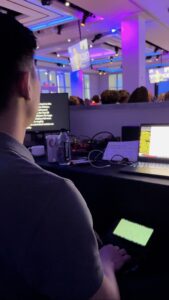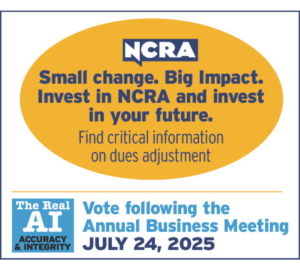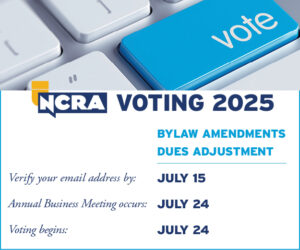At the Nov. 3 NCRA Board of Directors meeting, the Board adopted the term captioners to describe any person practicing broadcast or CART captioning in the field. This change came on the recommendation of the CRC Certification Committee and the Broadcast and CART Captioning Committee. The proposal was part of the committees’ long-term strategy to aid practitioners in the marketplace by using the terms most understood by the people using the service.
The co-chairs of the Broadcast and CART Captioning Committee (Steve Clark, CRC, and Cynthia Hinds, CRC) and the co-chairs of the CRC Certification Committee (Karyn Menck, RDR, CRR, CRC, and Carol Studenmund, FAPR, RDR, CRR, CRC) proposed the change in a letter, explaining: “Twenty years ago, most captioners did either broadcast work or CART captioning. … Over the past five years, we have recognized that the overlap between the two groups was broad enough that we merged the two committees into the Broadcast and CART Captioning Committee.”
The letter to the Board noted that maintaining the distinction between broadcast and CART captioning also leads to confusion among consumers, placing additional barriers to finding someone who can provide the correct service.
“I know to most people, this change is pretty subtle,” said Studenmund after the Board adopted the change in terminology. “Some of us had legitimate concerns that when someone went to find a captioner, they would only see people who chose to be identified as CART captioners and didn’t realize the person was fully capable of working in the broadcast world. I can’t tell you how many times I have tried to explain to people who need our captions what CART captioning is as opposed to broadcast captioning, only to then see them look at each other and say, ‘It’s captioning.’”
Many captioners already provide a wide range of services, using the necessary devices for the assignment, providing CART services when asked and signing up for captioning shifts through one or more captioning companies. In addition, many captioners find new ways to offer their services that use a combination of technologies available. “Captioners don’t get up and say, ‘Today I’m going to be a broadcast captioner from 10-11 a.m., then go work as a CART captioner from 1-3 p.m., and later go back to broadcast captioning when I cover the 11-11:35 p.m. local news,’” Studenmund said. “We are all captioners, and we love what we do.”
This change in NCRA usage is only applicable to the overall categorization. “We are still going to talk about CART captioning to our friends in the hearing disabled community in the work NCRA does for us in Washington, D.C.,” explained Studenmund, “and we will still talk about broadcast captioning when communicating with the Federal Communications Commission.”
Following through on this change, as the Association updates the language from CART captioners or broadcast captioners to captioners in the print and online NCRA Sourcebook, NCRA members affected by the change will be contacted by email about making sure that their information is accurate.












